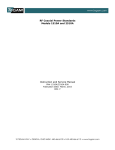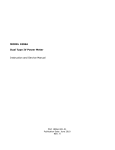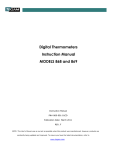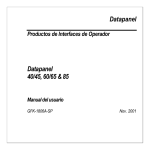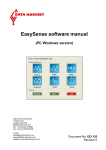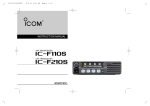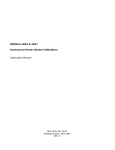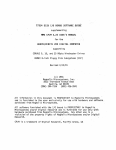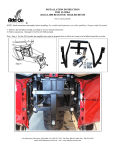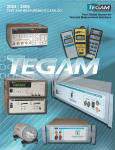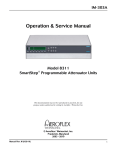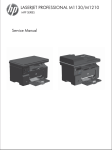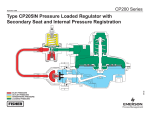Download SYSIIB Overview
Transcript
TEGAM INC. System IIB POWER SENSOR CALIBRATION SYSTEM System Overview PN# SYSIIB-903-01CD Publication Date: September 2006 REV. A NOTE: This user’s manual was as current as possible when this product was manufactured. However, products are constantly being updated and improved. Because of this, some differences may occur between the description in this manual and the product received. TEGAM is a manufacturer of electronic test and measurement equipment for metrology, calibration, and production test. We also provide repair, calibration, and other support services for a wide variety of test and measurement equipment including RF power sensor calibration systems, RF attenuation measurement systems, resistance standards, ratio transformers, arbitrary waveform generators, micro-ohmmeters, LCR meters, handheld temperature calibrators, thermometers, humidity and temperature control devices, and more. TEGAM also repairs and calibrates test and measurement equipment formerly manufactured by Electro-Scientific Industries (ESI), Gertsch, Keithley Instruments, Lucas Weinschel, and Pragmatic Instruments. A complete list can be viewed on our Product Service Directory at www.tegam.com For more information about TEGAM and our products, please visit our website at www.tegam.com: or contact one of our customer service representatives at [email protected] or 800-666-1010. Ten Tegam Way Geneva, Ohio 44041 Telephone: (440) 466-6100 Fax: (440) 466-6110 E-mail: [email protected] System Overview Figure 1 System IIB Description of System IIB Functional Description The TEGAM System IIB is a precision power measurement system that measures microwave power within the frequency bandwidth of the thermistor standard(s) being used in the system. The primary application of this system is for automated power sensor calibration directly traceable to primary standards. The System IIB has three main components: an RF Power Standard, a Dual Type IV Power Meter, and Automated Calibration Software. The RF Power Standards are temperature controlled thermistor based RF power sensors which come in a two basic configurations: Terminating Reference Standards and Feedthrough Working Standards. There are different models of both configurations based on frequency range. For more information about TEGAM RF power standards, refer to the Coaxial Power Standards Instruction Manual IM-300. The Dual Type IV Power Meter, Model 1806A, has two self balancing DC substitution bridges that detect changes in RF power applied to a thermistor type power sensor. Changes in DC substituted power are used to accurately calculate an RF power level which is then used for comparison with the power level detected by the Device Under Test (DUT). The ratio of the two power levels is the DUT calibration factor. For more information refer to the 1806A Dual Type IV Power Meter Instruction and Service Manual 1806A-901-01CD. SureCAL® Automated Calibration Software is used to automate the calibration process. Measurements are transmitted on a serial bus. The software calculates results and uncertainty, prints reports, certificates and labels, and will update sensor EPROM’s. For more information refer to the SureCAL® Test Manager V5 User’s Guide and SureCAL®’s “Tips for First-Time User’s of the Power Sensor Support Package”. System IIB RF Power Sensor Calibration System 1 System Overview Physical Description All System IIB packages include: 1806A with ANSI/NCSL Z540-1-1994 Compliant Calibration with Data SYSII-SureCal software 138-645A accessory kit Three 1583-3 GPIB cables 1585-1008 RF cable Refer to the Table 1 below for additional items included with each system package. Model (Description) SYSIIB-k18 (100 kHz to 18 GHz) SYSIIB-k18B (100 kHz to 18 GHz) Table 1 Instruments Specific to Each System IIB Package F1130 M1130 F1135 M1135 (Working Standard (Reference Standard (Working Standard 100 kHz to 18 GHz) 100 kHz to 18 GHz) 0.01 to 26.5 GHz) X X X (10 MHz to 26.5 GHz) SYSIIB-26B (10 MHz to 26.5 GHz) (100 kHz to 26.5 GHz) SYSIIB-k26B (100 kHz to 26.5 GHz) 1820 (Mount Heater for Two Mounts) X SYSIIB-26 SYSIIB-k26 (Working Standard 0.01 to 26.5 GHz) X X X X X X X X X Specifications Refer to the Coaxial Power Standards Instruction Manual IM-300 and the 1806A Dual Type IV Power Meter Instruction and Service Manual 1806A-901-01CD for physical and electrical specifications. Additional equipment Table 1.2 lists the additional equipment required to calibrate RF power sensors with the System IIB. The description for each piece of equipment listed states the minimum recommended requirements for that piece of equipment. There may be many models that meet the minimum requirements; it is up to the operator to select the specific model. Measurement uncertainty will vary depending on the additional equipment used. Please refer to the specifications for the particular model to get that information. 2 System IIB RF Power Sensor Calibration System System Overview Signal Generator DVM RF Power Meter IBM compatible PC Table 1.2 Additional Equipment Required Continuous Wave, 6 dBm to 12 dBm output power, Frequency Range compatible to standard(s); two may be required to cover entire Frequency Range. DC Volts, 6½-digit minimum resolution. Compatible with the device under test. Pentium class processor 200MHz, 32MB RAM, WINDOWS 95, 98, NT, Me, 2000, or XP Operating System with utilities, 300 MB Hard Drive, 8X CD ROM Drive to load SureCAL® software and periodic updates, National Instruments or Hewlett Packard IEEE-488 Bus controller board, parallel port for report printing (unless connected to a local area network), and serial port for label printer. Connecting the System IIB Figure 2 shows how to connect the functional components of the System IIB and the additional equipment for a typical power sensor calibration. To connect an RF Power Standard to the 1806A, the heater in the standard must be connected to the 1806A’s heater control connector. To do this, simply connect one end the appropriate cable to the “TEMP” or heater connector on the standard and the other end to the “TEMP” connector on the 1806A. For Models F1125, F1130, and F1135 use cable P/N 1000008, for Models M1125, M1130, and M1135 use the cable P/N CBL-F1125-48. Both types of cables are supplied with the 1806A. Next, the BIAS VOLTAGE red and black connectors are cabled to the BIAS VOLTAGE red and black connectors on the TEGAM Model 1806A. The BIAS VOLTAGE connectors are 5-way binding posts so banana plugs or spade lugs can be used. Cables with spade lug connectors are supplied with the 1806A. The RF IN on the Feedthrough Working Standards (Models F1125, F1130, F1135) is an SMA female coaxial connector. It is connected to the output of the chosen signal generator, which should be 50 Ohm nominal impedance. A low loss coaxial cable is recommended to avoid an excessive power loss. The Working Standards have another additional female coaxial connector called the “SENSOR” port. This connector is actually one of the arms of an RF power splitter. The Device Under Test is connected to this port for calibration. When the Working Standard is being calibrated, the Terminating Reference Standard is connected to this port. This connector is an N type female on the Models F1125 and F1130 and a 3.5 mm female on the F1135. Proper care, cleaning, alignment, and torquing of coaxial connectors should be practiced to reduce insertion loss and extend the life of the connectors. The RF input on the Terminating Reference Power Standards (Models M1125, M1130, M1135) is a male coaxial connector that is connected to the RF power source to be measured. This connector is a type N on the M1125 and M1130 and is a 3.5 mm on the M1135. Again, proper care, cleaning, alignment, and torquing of coaxial connectors should be practiced to reduce insertion loss, improve repeatability, and extend the life of the connectors. The Model 1806A does not measure the RF power level directly. Instead, a Digital Voltmeter (DVM) measures DC voltages before and after the application of RF power to the thermistor based standard. The 1806A VOLTMETER red and black connectors are connected to the DVM DC voltage positive and negative input connectors respectively. The VOLTMETER connectors are 5-way binding posts so banana plugs or spade lugs can be used. SureCAL® Automated Calibration Software controls the DVM, signal generator, and DUT power meter through an IEEE-488 General Purpose Interface Bus (GPIB). Each of these instruments should be connected to the PC where SureCAL® is installed using quality IEEE-488 GPIB bus cables. Three cables are included in every System IIB package. Each instrument will need to have a unique GPIB address that will be entered into SureCAL®. System IIB RF Power Sensor Calibration System 3 4 GPIB TEMP System IIB RF Power Sensor Calibration System BIAS VOLTAGE TEMP RF Output V+ V- VOLTMETER Signal Generator DVM or DMM READY ERROR ON TEST OFF READY ERROR BIAS VOLTAGE VOLTMETER ON TEST OFF Model 1806A GPIB GPIB GPIB RVG PC Running SureCal Measurement from SUT Frequency and Power Level Commands TEMP Dual Type IV Power Meter Measured Cal Transfer DC RVG RF BRIDGE B DUT Figure 2 Typical Setup for Calibrating RF Power Sensors with the System IIB O POWER I TEGAM SENSOR RF TRANSFER STANDARD MODEL F1130 BRIDGE A BIAS VOLTAGE RF IN TEGAM Power Meter System Overview System Overview Operation Once the standard(s) has been correctly connected to the 1806A, allow at least 2 hours for the standard to reach operating temperature after connecting the heater. The READY indicator on the 1806A will illuminate once the mount has reached its operating temperature. Allow at least one hour after the BIAS VOLTAGE terminals are connected before taking any measurements. The SureCAL® software included in the System IIB takes care of all the measurement and mathematic operations necessary to characterize an RF power sensor. The proceeding paragraphs are for information only. The System IIB does not measure the RF power level directly. Instead, it uses a technique called DC substitution to determine RF power through DC voltage measurements. A Digital Voltmeter (DVM) measures DC voltages before and after the application of RF power to the thermistor based standard. The amount of RF power detected by the thermistor is derived from those voltage measurements. The cal factor for the DUT is determined by dividing the power read by DUT power meter by the RF power detected by the standard. For more details refer to the 1806A Dual Type IV Power Meter Instruction and Service Manual 1806A-901-01CD and the Coaxial Power Standards Instruction Manual IM-300. It may be necessary to use an adapter or attenuator to calibrate a particular power sensor. If the sensor’s power range is below 0 dBm (1 mW) then an attenuator is needed. If the sensor does not have a male connector that is the same type as the SENSOR port of the Working Standard then an adapter would be needed. A 50 to 75 Ohm matching pad is needed to calibrate 75 Ohm sensors. Any device placed between the SENSOR connector and the DUT will affect the calibration results and its loss (attenuation) must be characterized and corrected for. A kit containing some adapters and attenuators along with correction data (P/N 138-645A) is included with the System IIB. The characterization data is provided in a format that the SureCAL® software can use to correct for losses in the device. Due to the high repeatability of the RF Power Transfer Standards and the accuracy of the Type IV Bridge, the major sources of error stem from the uncertainty of the calibration factor of the standard and impedance mismatch. When an RF Power Standard is calibrated, an uncertainty is reported for each calibration point. This uncertainty figure is one of the largest contributors to the uncertainty budget for the calibration at the next level. Impedance mismatch causes some of the RF power to be reflected back from one device to another; thus, the maximum amount of RF power is not transferred from one device to another. Reflection coefficient of an RF device is a vector quantity that describes how much its impedance varies from the nominal (50 Ohms). The reflection coefficient for TEGAM RF Power Transfer Standards is included as part of the factory calibration data. If both the magnitude and phase angle of the reflection coefficient are known for the DUT, then Gamma corrections can be applied to the calibration factor. Applying Gamma corrections to the calibration factor reduces the total uncertainty of the calibration by eliminating the impedance mismatch term. System IIB RF Power Sensor Calibration System 5 System Overview Contacting Tegam In the event of any questions or concerns regarding the System IIB, contact TEGAM. An apparent malfunction of the system may be corrected over the phone or by e-mail. Contact TEGAM using the following: Tegam, Incorporated Ten Tegam Way Geneva, OH 44041 USA ww.tegam.com 800-666-1010 toll-free 440-466-6100 phone 440-466-6110 fax [email protected] e-mail DO NOT send any instruments back to the factory without prior authorization. When it is necessary to return an item, contact TEGAM customer service to obtain an RMA, (Returned Material Authorization), number. You can contact TEGAM customer service via the TEGAM website, www.tegam.com or by calling 440.466.6100 OR 800.666.1010. The RMA number is unique to your instrument and will help us identify your instrument and to address the particular service request by you which is assigned to that RMA number. Of even more importance is a detailed written description of the problem, which should be attached to the instrument. Many times repair turnaround is unnecessarily delayed due to a lack of repair instructions or lack of a detailed description of the problem. Warranty TEGAM, Inc. warrants its products to be free from defects in material and workmanship for a period of 1 year from the date of shipment. During this warranty period, if a product proves to be defective, TEGAM, Inc., at its option, will either repair the defective product without charge for parts and labor, or exchange any product that proves to be defective. TEGAM, Inc. warrants the calibration of its products for a period of 1 year from date of shipment. During this period, TEGAM, Inc. will recalibrate any product, which does not conform to the published accuracy specifications. In order to exercise this warranty, TEGAM, Inc., must be notified of the defective product before the expiration of the warranty period. The customer shall be responsible for packaging and shipping the product to the designated TEGAM service center with shipping charges prepaid. TEGAM Inc. shall pay for the return of the product to the customer if the shipment is to a location within the country in which the TEGAM service center is located. The customer shall be responsible for paying all shipping, duties, taxes, and additional costs if the product is transported to any other locations. Repaired products are warranted for the remaining balance of the original warranty, or 90 days, whichever period is longer. Warranty Limitations The TEGAM, Inc. warranty does not apply to defects resulting from unauthorized modification or misuse of the product or any part. This warranty does not apply to fuses, batteries, or damage to the instrument caused by battery leakage. 6 System IIB RF Power Sensor Calibration System System Overview Statement of Calibration TEGAM’s instrument have been inspected and tested in accordance with specifications published by TEGAM, Inc. The accuracy and calibration of this instrument are traceable to the United States National Institute of Standards and Technology through equipment which is calibrated at planned intervals by comparison to certified standards maintained in the laboratories of TEGAM, Inc. System IIB RF Power Sensor Calibration System 7









